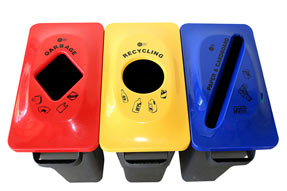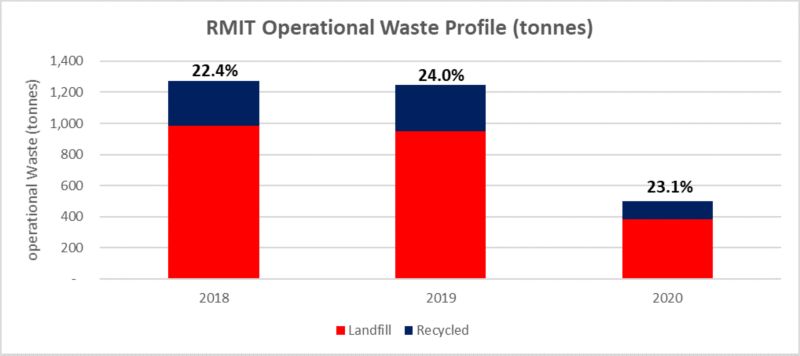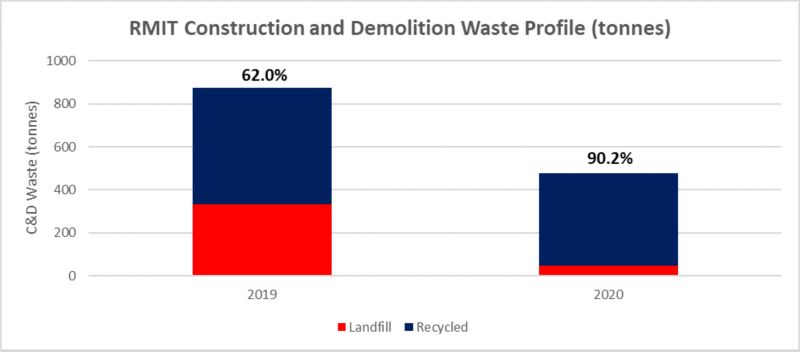Circular economy and recycling

RMIT University is committed to leading the shift into a circular economy that values resources and thinks holistically about our systems, processes and supply chains.
The circular economy aims to transform the current mindset of the take-make-waste linear model towards circularity, where waste and pollution is eliminated through good design, and the life of existing materials are prolonged through new and innovative ways of repairing, reusing and remanufacturing.
The Sustainability Team and the wider Property Service Group have been focusing on embedding the principles of the circular economy into the building portfolio operations and processes. The project aims to ensure that the environmental and economic benefits of embedding circularity are articulated, new methodologies and a measurement tool established and that the positive impacts are calculated.
The Circular Economy Project aims to:
The Circular Economy Hub (CEH) at RMIT is a cross-disciplinary, industry-engaged network of around 60 researchers and experts across the University working on cutting edge and innovative Circular Economy (CE) research across Australia and internationally.
The work supports RMIT as an industry leader in circular economy research at national and global forums. The CEH’s cross-disciplinary nature supports empirical approaches to holistic and systemic engagement across research partnerships, expanding the university’s impact and expertise on CE. It also supports the emergence of a new capability-building platform across micro-credentials, executive training, vocational and higher educational outcomes.
RMIT is leading a new ARC Industrial Transformation Research Hub for Transformation of Reclaimed Waste Resources to Engineered Materials and Solutions for a Circular Economy (TREMS) which will focus on reducing landfill waste and transforming reclaimed waste into new materials for use in construction and other manufacturing sectors. The hub will draw from expertise across multiple disciplines including civil, chemical, materials and construction engineering, artificial intelligence, behavioural sciences, environmental procurements and policies and standards.
For more information, visit:
RMIT Activator is the University’s growth engine for entrepreneurship and innovation. RMIT Activator has developed its programs and partnerships to align with RMIT’s strategic ambitions for sustainability and the UN Sustainable Development Goals (SDGs). RMIT Activator strives to expose students to ‘wicked problems worth solving’, through experiential programming, supports capability development and the connections needed to make a practical difference.
Since 2020, Activator has been supporting a range of initiatives to drive the circular economy, including global accelerator programs, hackathons, pitch events, mentoring programs and industry collaborations. RMIT Activator and CEH have collaborated in the formation of the Victorian Circular Activator (VCA): the brand new, beating heart of circular economic activity for our State. It is a collaboration between Circular Economy Victoria, RMIT University, RMIT Activator, Swinburne Data for Social Good Cloud Innovation Centre, Planet Ark and the City of Melbourne. The VCA is a physical space that supports the existing digital infrastructure underpinning circular innovation in Victoria. As part of Melbourne Knowledge Week, RMIT Activator and the VCA hosted a live exhibition, where attendees had the opportunity to explore some of the latest innovations driving our city’s transition towards a circular economy.
We promote the waste hierarchy of ‘Reduce, Reuse, Recycle’ to minimise our impact on the environment. Too often we focus on only recycling our waste, without firstly considering if we can eliminate the waste or limit the amount of waste produced by reusing items.
Here are some things as part of the RMIT community you can do to help reduce waste:
If in doubt, throw it out
RMIT has rolled out a standard three bin system across all campuses within staff office areas, and some general areas. This includes removal of under-desk bins and replacement with a multi-bin system that supports the primary waste streams. Comprising of one set per 20-30 desks; the system is being rolled out to other office areas through a planned rollout with our cleaners and refurbishment projects. The convenient, centralised locations promote recycling, moving away from landfill-only under-desk bins. Much of what we throw away can be re-used or recycled, and centralised stations support these behaviours. As well as being good for the environment, getting up from your desk to break up prolonged sitting has the added benefit of being great for your health
 RMIT's three bin system
RMIT's three bin system
RMIT supports the recycling of all materials that can be recycled, and only a small amount of residue waste should end up in landfill. However, due to the operational constraints at RMIT as well as some limitations to the current Victorian waste industry's recycling capabilities, RMIT cannot provide collection services for low-volume and unique recyclable waste streams. Instead, RMIT focuses on waste avoidance and improving our landfill diversion rates for our high-volume, primary waste streams.
Individuals, portfolios and colleges can implement initiatives to reduce their waste footprint. The RMIT Sustainability Team are happy to provide advice on how waste can be further reduced or segregated to minimise landfill contributions.
Find out more on the Life on campus web page.
What is electronic waste or e-waste?
E-waste is any electrical or electronic equipment that has been discarded. Anything that is powered by an electrical source is classified as e-waste.
Examples of e-waste include:
The amount of e-waste (electronic waste) we create is growing up to three times faster than general municipal waste in Australia. These items contain both hazardous and valuable materials that can be recovered when they reach the end of their working life. Acknowledging the risks and opportunities associated with e-waste, the Victorian Government banned e-waste from Victoria’s landfill on 1 July 2019. E-waste at RMIT cannot be disposed of in any of our standard waste or recycling bins.
Most of RMIT IT assets are leased and must be returned back to the supplier at the end of its life and should not be disposed of. If the particular IT or any other electronic equipment is not a leased asset and need to be disposed, they must not be disposed in any or RMIT's primary waste streams.
To ensure that the IT or electronic equipment is disposed of correctly, RMIT staff should please contact the Property Services Desk and specifically request for 'electronic waste disposal'.
You can organise the collection of printer cartridges through Ricoh via this online form.
You can order a Battery Bucket for your area through the Property Services, Service Desk. The cost per bucket, which includes supply of bucket, costs of recycling and certification on empty is $148.00 ex. GST which is chargable on the supply of the bucket.
To minimise typical office supplies going into landfill during an office clean out, order a box or cage from Green Collect.
Green Collect specialises in finding the best environmental solution for a variety of hard to recycle office items such as small electrical items, folders, ring binders, pens, pencils, sticky notes, document trays, DVDs, shredders, etc.
Organics waste collection was successfully introduced to all on-campus retailers back-of-house areas in 2019 which saw a significant increase in the amount of organics waste diverted from landfill.
RMIT's organics waste is sent to a commercial composting facility where the waste is turned into high quality compost. Food and organics waste stream have only been introduced at on-campus retailers' back of house areas as it it is easily segragated and controlled. This waste stream will not be introduced to any other locations at RMIT due to the composting facility's high sensitivity towards contamination with other waste streams. If food and organics waste stream is contaminated with other waste products such as metals and plastics it may be rejected and sent to landfill.
RMIT is committed to avoiding the disposal of any furniture if it is still fit-for-purpose and safe for occupants to use. Furniture cannot be recycled in RMIT's primary waste streams as it is made from many composite materials that cannot be separated easily. To ensure that furniture is reused, repaired, repurposed before it is disposed of, RMIT staff should please contact the RMIT Property Services desk.
Terracycle recycles both Nescafé Dolce Gusto and Nespresso coffee capsules. Sign up for this on the Terracycle website, print your free label, package the pods and take them to your nearest free drop off point or send from your nearest Australia Post location.
Multi-sort waste bins (red, yellow and blue) can be ordered through the Property Services, Service Desk. If you are running an event, or have a significant amount of waste, extra ad-hoc bins can also be ordered through the service desk.
Generally, cleaners will do this if they notice contamination of the recyclable stream (for example, a half-eaten sandwich). To avoid this please ensure your recyclable materials are free from contamination prior to placing in a recyclable bin. We strive for continual improvement with our contractors processes to ensure they dispose of wastes appropriately.
We have approached recycling organisations about providing a soft-plastic collection service specifically for RMIT, but most have no plans to extend their existing network. The REDcycle group have an extensive drop-off network, so we suggest you drop your soft-plastics off at one of their existing sites.
RMIT aims to improve waste management practices across the campuses. RMIT’s Waste Management Plan is designed to divert waste from landfill by following the waste hierarchy of avoidance, minimisation and recycling.
In 2020, RMIT Australian operations produced a total of 498 tonnes of waste. The overall waste profile was down 60% on 2019 levels, primarily due to the impacts of COVID-19 and the move to remote learning. The landfill waste produced is equal to 7.5kg per student. Our waste diversion rate in 2020 was 23%.

In 2019 RMIT began formally reporting on the Construction and Demolition (C&D) data, which was provided by the principal contractor on each of RMIT’s capital projects. In 2019, 22 of RMIT’s capital development projects across 17,600 m2 of Gross Floor Area provided C&D waste data. From these projects, 876 tonnes of waste was produced and 62 per cent diverted from landfill. This allowed RMIT to then establish a benchmarking for the diversion of C&D waste. As RMIT began to drive ‘circular thinking’ into the capital development process, the results of the pilot program in 2019 resulted in 1,200 items or 27 tonnes of materials reused and, subsequently, diverted from landfill.
In 2020, RMIT continued to drive these outcomes and measure the economic, social and environmental impacts of implementing circular economy principles, avoiding waste and strengthen reuse, setting a benchmark to divert 90% of all construction and demolition waste. As a result, in 2020, RMIT had 18 active capital development projects providing C&D waste data. From these projects, 499 tonnes of ‘waste’ was produced and achieved its target of 90% diversion from landfill, with only 48kg of waste sent to landfill

Acknowledgement of Country
RMIT University acknowledges the people of the Woi wurrung and Boon wurrung language groups of the eastern Kulin Nation on whose unceded lands we conduct the business of the University. RMIT University respectfully acknowledges their Ancestors and Elders, past and present. RMIT also acknowledges the Traditional Custodians and their Ancestors of the lands and waters across Australia where we conduct our business - Artwork 'Luwaytini' by Mark Cleaver, Palawa.
Acknowledgement of Country
RMIT University acknowledges the people of the Woi wurrung and Boon wurrung language groups of the eastern Kulin Nation on whose unceded lands we conduct the business of the University. RMIT University respectfully acknowledges their Ancestors and Elders, past and present. RMIT also acknowledges the Traditional Custodians and their Ancestors of the lands and waters across Australia where we conduct our business.